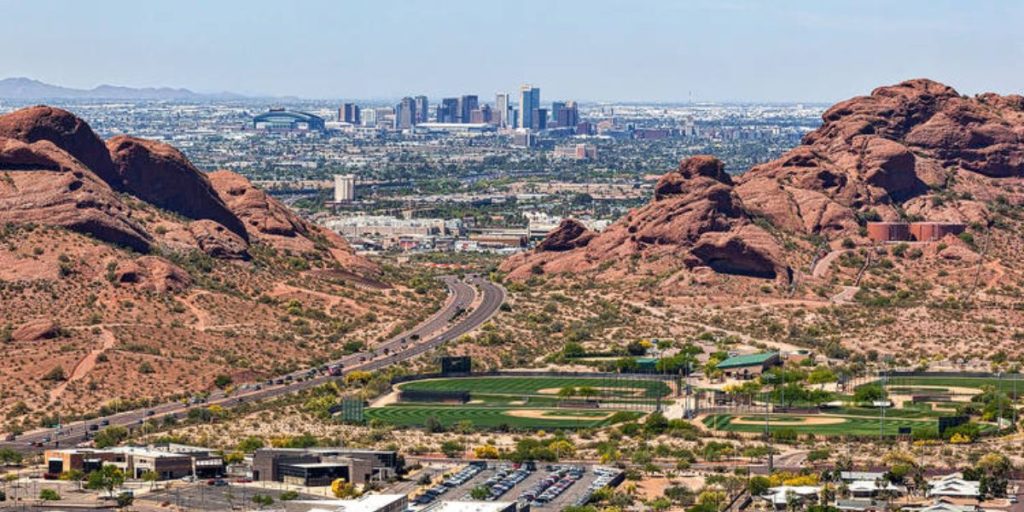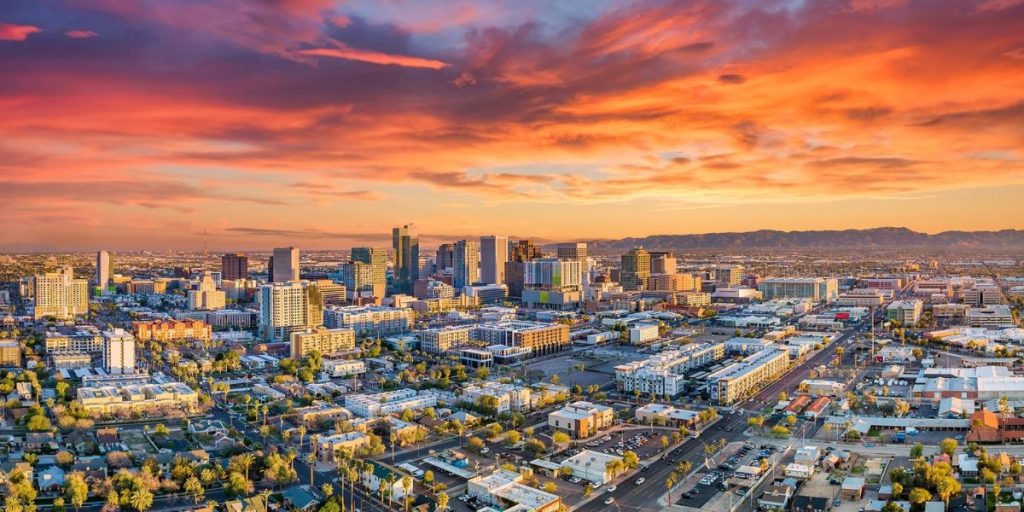Arizona’s most populous metropolis ranks among the largest in the US, alongside Chicago, Illinois, and Houston, Texas. Arizona was admitted to the Union in 1912 and is located in the southwest area of the United States.
The state has a population of over 7.36 million people and an area of about 114,000 square miles. In this article, let’s Discover the state’s largest city and if it will still be the largest in Arizona by 2050.
What is the largest city in Arizona?
PHOENIX is Arizona’s largest city and the state capital. Phoenix has a population of 1.6 million people, with a metropolitan area population of 4.8 million, according to 2020 predictions. Furthermore, Phoenix’s overall area exceeds 500 square miles, making it a massive capital city.
Phoenix is the fifth-largest city in the United States. Moreover, Phoenix is the most populous state capital in the country. Finally, the Phoenix metropolitan area’s population growth rate is projected to be 1.56% by 2022.

Phoenix Statistics and Economy
According to the United States Census Bureau, Phoenix has a population density of 3,104.5 people per square mile. In addition, the median household income in Phoenix is $64,927. Furthermore, Phoenix’s Gross Domestic Product (GDP) is estimated to be 261.71 billion US dollars in 2021. Phoenix’s GDP per capita is $44,534 as of 2017.
Tourism, financial services, and manufacturing are the primary industries that underpin Phoenix’s economy. Furthermore, agriculture contributes to Phoenix’s sustainability by producing crops such as cotton, vegetables, and fruits. Agriculture was previously the city’s biggest industry, but it has since been replaced by more contemporary industries and improvements. In fact, the city’s major employers are in finance and banking, as well as hospitality and tourism.
What draws people to Phoenix?
Phoenix is a densely populated city for several reasons. For starters, there are several career prospects in the area in industries such as manufacturing, transportation, health care, and technology. In fact, Phoenix’s unemployment rate is currently 3.1%, lower than the national average of 3.6%. Furthermore, Phoenix’s cost of living is below the national average for large cities.
Furthermore, the weather may be the most appealing aspect about Phoenix. While Phoenix’s climate is hot and dry, the city gets over 300 days of sunshine each year. Furthermore, even on hot days in this metropolis, humidity is rare. As a result, many individuals opt to live in Phoenix because of the great weather all year round.
What will be Arizona’s largest city in 2050?
TUCSON is Arizona’s second-largest city, with a population of 546,019 and a metropolitan area population of more than one million. Tucson has a total size of around 238 square miles. Tucson’s population growth rate for 2022 is 0.61%.
Given Tucson’s population and growth rate, it is doubtful that it will exceed Phoenix by 2050. For example, Phoenix’s population continues to outnumber Tucson’s whole metropolitan region. Meanwhile, Phoenix’s metropolitan area population is four to five times that of Tucson. Furthermore, Phoenix’s annual population growth rate is far higher than that of Tucson.
As a result, Phoenix is expected to become Arizona’s largest city by 2050. However, some climate experts fear Phoenix may become uninhabitable by 2050, raising the question of whether another Arizona city would become the state’s largest by population.
Phoenix Climate Forecast
According to ETH Zürich, Phoenix’s environment could become much hotter and drier by 2050. The study found that San Diego and Phoenix would experience temperatures comparable to the Middle East and Africa by comparing future and present climates. Phoenix was expected to have a hot temperature like Baghdad.

Why is Phoenix getting hotter and drier? All stems from climate change. Chemical reactions trap heat near the Earth’s surface as fossil fuel emissions enter the atmosphere. So, surface temperatures rise and climates warm. In Phoenix, summer temperatures often range from mid-90s to over 105ºF. In contrast, Baghdad experiences high temperatures ranging from 98ºF to 112ºF. Phoenix appears to be reaching Baghdad’s climate and temperatures.
Rainfall is scarce in Phoenix. The city receives about eight inches of rain annually. Baghdad receives only six inches of rain annually, with no rain in summer. Over the past 20 years, Arizona has experienced severe drought. Lake Mead is drying up due to climate change, low rainfall, and increased evaporation.
Phoenix climate effects
Phoenix’s drought, high temperatures, and dry weather will hurt several industries. Agriculture cannot function or gather crops during extreme drought. Food and livestock farming is extremely difficult without water. Therefore, farmers may leave for greater jobs and prospects abroad.
Arizona’s low-income population also faces drought and scorching temperatures. High temperatures and water scarcity make it hard for low-income residents to stay cool. Air conditioning is expensive in low-income neighborhoods, making them vulnerable.
Phoenix inhabitants with health issues, especially the elderly, may also suffer from the heat. Heat strokes and other heat-related health conditions can occur in Phoenix, and those without the resources and services to prevent them may suffer the most.